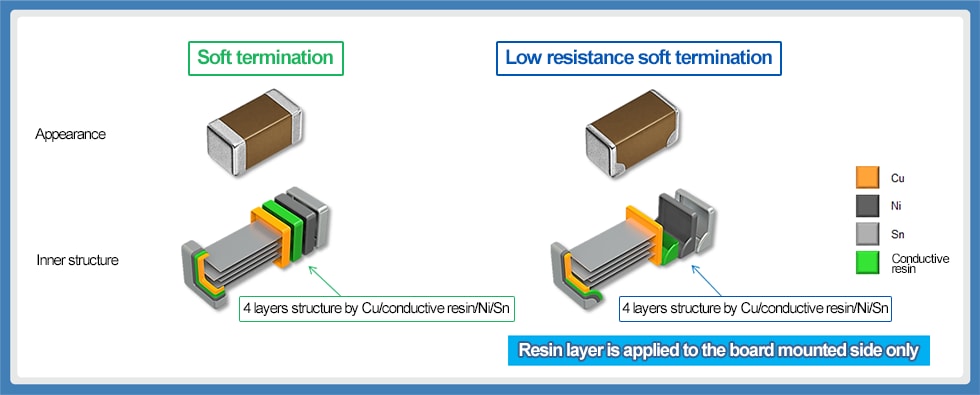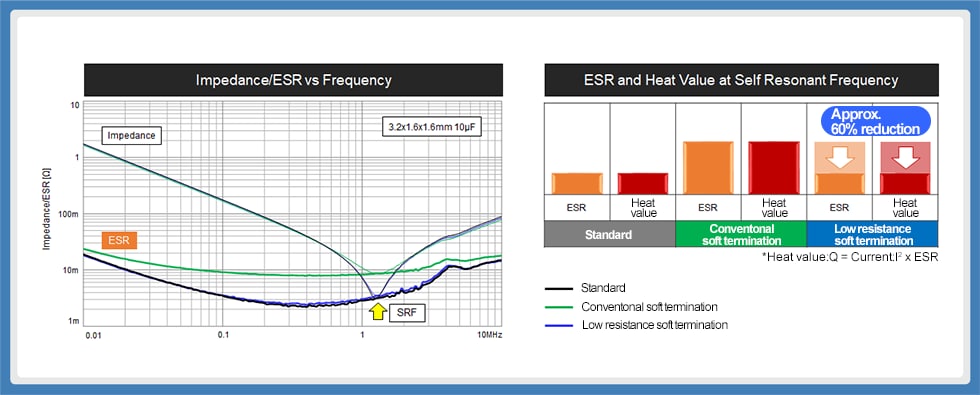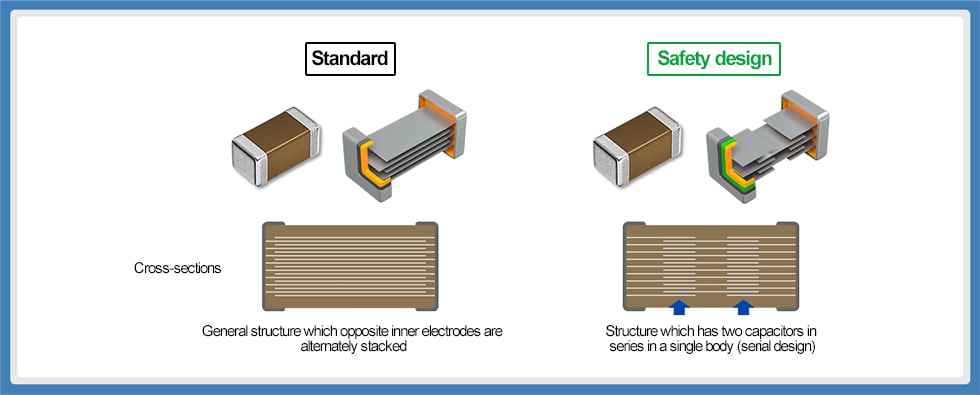Solution Guides
Summary of Flex Crack Countermeasures Using High-reliability MLCCs
Fig1: Element cracking (cross-section)
Major causes of flexure cracks and influence on reliability
One of the major reasons of ceramic element cracks in MLCCs is due to board flexure stress occurred by a variety of reasons.
・Handling during manufacture: Stresses by suction nozzle, inappropriate solder amount, different thermal expansion between MLCC and board, board splitting, screw cramp and excessive board bending, etc.
・Handling in use: Stresses by drop shock and vibration, etc.
Fig. 2 Cases of high stresses acting on MLCCs
MLCCs near screws or board splitting
Board having large thermal expansion
Excessive board flexure during board manufacturing or assembly
Ceramic elements are strong against compression stress, though weak against tensile stress, thus, a crack is easily generated in the element when excessive stress is acting on a soldered MLCC from the board direction. Then, a short circuit failure mode occurs if electrical conduction happens between opposite internal electrodes.
Even if there is an open circuit mode at the beginning of the crack occurrence, it may progress to a short circuit mode while the product is on the market. The short circuit mode may cause problems such as abnormal heat generation or ignition of the MLCC, and so suitable countermeasures are required.
Fig. 3 Major causes of flexure cracks and influence on reliability
Applications which flexure crack countermeasures are effective
There is a risk that microcracks occurring in the various processes from component mounting to set assembly will progress to ceramic element cracks while the end product is on the market. Special caution is required especially in case of the following applications.
・Equipment which is constantly exposed to vibrations and/or shocks: equipment of automobiles, railway vehicles and industry, etc.
・Equipment which is exposed to frequent shock by dropping: mobile devices and smart key, etc.
Furthermore, with the equipment used in a humid environment, moisture by condensation may penetrate into the element crack, thereby the risk which open circuit mode progresses to a short circuit mode increases.
Fig. 4 Applications which flexure crack countermeasures are effective
Equipment which is constantly exposed to vibrations and/or shocks
Equipment which is exposed to frequent shock by dropping
Equipment used in a humid environment
In order to reduce the risk of short circuit generation due to board flexure, TDK highly recommends five high-reliability MLCC series.
1 Soft termination relieves flexure stress and reduces load applied to ceramic element
Soft termination
The terminal structure of soft termination type is different from standard type. Standard type has a three layered structure made of copper, nickel and tin, whereas soft termination type has a resin layer between the copper and nickel, thus four layered structure is formed. The resin layer relieves mechanical stress and provides protection from cracks.
Fig. 5 Structure comparison
No element cracks were observed even after board was flexed up to 10mm
The effect can be confirmed by board flexure test. Whereas element cracks were observed after the board flexure 10mm in case of standard type, with the soft termination type, no cracks were found.
Fig. 6 Results of board flexure test
Suppression of element crack occurrence by resin electrode peeling
When excessive stress was continuously applied, cracks occurred in the ceramics element in a standard product. In contrast, with the soft termination product, no cracks were found in the element, though there was a peeling of the nickel layer and the resin layer. This shows that the resin layer has an excellent effect to suppress element cracks.
Fig. 7 Element crack and resin electrode peeling
No crack occurred even after 10,000 times drop test (*not a guaranteed item)
The drop test was performed assuming mobile applications. In the soft termination product, no cracks occurred even after 10,000 times drop test, thereby this shows that the resin electrode relieved the shock.
Fig. 8 Results of drop test
【Advantages of soft termination】
- High resistance to mechanical stress and thermal shock by resin layers
- X8R and X8L type whose maximum temperature are up to 150°C are available
- C0G type having excellent stable temperature and DC-bias characteristics is also available
【Major applications】
- Fail-safe design for battery line
- Prevention of ceramic element crack by board bending
- Prevention of solder crack by thermal shock
- Equipment such as mobile devices and smart key having a high possibility of drop
【Soft termination】Product information and sample purchase
Commercial grade
Automotive grade
2 Integration of both high reliability and low resistance by original terminal structure
Soft termination (low resistance type)
Soft termination MLCCs have a conductive resin layer within the terminals to provide mechanical stress relief, however, the layer has additional resistance including the ESR characteristic. With the aim of suppressing this disadvantage, new type of soft termination product with original terminal structure has been developed. The material constituents of terminal are the same as conventional soft termination, however, the resin layer is applied to the board mounted side only.
Fig. 9 Low resistance type with original terminal structure
Effective stress relief by applying the resin layer to the board mounted side only
The purpose of this design is explained from a viewpoint of board flexure stress. The mechanical stress by board bending primarily concentrates at the bottom of the terminals on the board mounted side. Low resistance type provides effective stress relief by applying the resin layer to the risk area only, not to whole area of the terminal.
Fig. 10 Mechanical stress to MLCC by board flexure
Current passing through terminal electrode
The advantages of this structure are described due to the difference in current path passing through the terminal. In case of the conventional soft termination products, the entire surface of terminal is covered with the resin, so electric current must pass through the resin layer. Because the layer has a higher resistance than metals such as copper, the total resistance is slightly higher than that of standard type products. In contrast, the new design allows the current to pass outside the resin layer. Therefore, the resistance rise is suppressed at the same level as the standard type.
Fig. 11 Current passing through terminal electrode
Reduction in Impedance/ESR
The effect is shown in the impedance/ESR frequency characteristics. The resistance value of the conventional soft termination (green) is higher than standard type(black), while low resistance type (blue) shows the same level as standard type. At the self resonant frequency (SRF), the ESR of the low resistance type is approximately 60% lower than the conventional soft termination type, and a similar reduction in heat generation can be expected (heat value is proportional to ESR). Furthermore, keeping a similar impedance and ESR reduces the risk of switching from standard type to soft termination type, the shift to soft termination may be encouraged.
Fig. 12 Impedance / ESR frequency characteristics, ESR / heat value at self resonant frequency
Board flexure resistance: Same level as conventional soft termination product
Next, the results of the board flexure test is shown. In case of soft termination product, no element cracks were observed in both conventional and low resistance type even after the board was flexed up to 10mm. From the results, it is clear that low resistance type has realized both the board flexure resistance and low electric resistance.
Fig. 13 Results of board flexure test
【Advantage of low resistance soft termination】
- Because the current can pass outside the higher resistance path due to applying the resin layer to the board mounted side only, low electric resistance has been realized.
【Major applications】
- Fail-safe design for battery line
- Prevention of ceramic element cracks by board bending
【Soft termination (low resistance type)】 Product information and sample purchase
Commercial grade
Automotive grade
3 Serial structure decreases risk of short failures by crack (+soft termination)
Safety design
Safety design type is a product which has two capacitor structures in series in a single body.
Fig. 14 Internal structures of standard and safety design product (serial design)
Advantages of serial design
If a crack which is occurred by board bending passes through between opposite internal electrodes, the risk of short failure increases due to the conduction by humidity.
Fig. 15 Flexure crack in standard product
In case of safety design product, even if the crack occurs in left capacitor structure, short circuit is prevented because right capacitor structure remains.
Fig. 16 Flexure crack in safety design product
Adoption of soft termination
Additionally, safety design product as well as soft termination product has high resistance to mechanical stress and thermal shock by resin layers. Thus, safety design product is an outstanding high reliability product.
Fig. 17 Structure comparison
Example of replacement with safety design product
Two capacitors are often mounted in series to decrease the risk of short circuit caused by cracks in battery line. With the safety design product, the serial design in a component acts as the prevention function, therefore the product will contribute to reduce the number of MLCCs.
Fig. 18 Example of replacement with safety design product
【Advantages of safety design】
- Serial structure decreases risk of short failures by crack
- High resistance to mechanical stress and thermal shock by resin layers
【Major applications】
- Fail-safe design for battery line
- Circuits requiring safer design



























